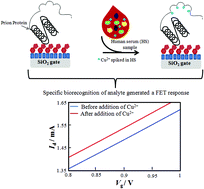Label-free detection of Cu(ii) in a human serum sample by using a prion protein-immobilized FET sensor†
Abstract
We have developed a field effect transistor (FET) sensor to sensitively detect copper ions (Cu2+) in a human serum (HS) sample for promising health-care diagnosis. By utilizing a Cu2+-binding prion protein that was immobilized on the FET gate surface, such an FET sensor can provide a simple, label free and highly selective performance, even in HS samples. We demonstrated the sensitivity of the sensor at the nanomolar level, 0–100 nM, which is very useful for the detection range of Cu2+ deficiency in practical applications.


 Please wait while we load your content...
Please wait while we load your content...